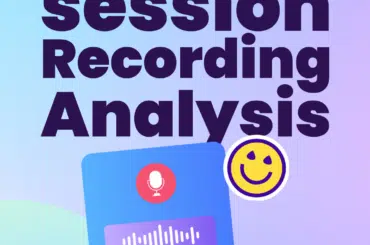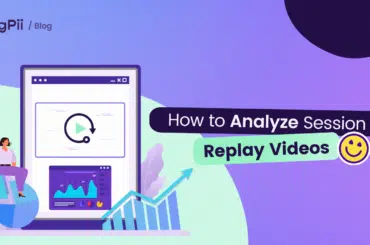Good session recordings give a deep insight into user behavior and patterns.
Unfortunately, analyzing session recordings are also one of the most time consuming and problematic tasks when it comes to analyzing them systematically, especially if you have a very large set of session recordings.
In this article, I will show you how you can identify user patterns from session recordings. In particular, we will use clustering methods that group similar behavior together in order to find out what kind of sessions tend to look similar from a certain point on in time, e.g.: “Do users sharing similar behavior x before page y always share different behavior z after page y?”
- Understand session recordings
- Why session recordings are a pain in the neck?
- Quantity – How to group your sessions?
- Which sessions to watch?
- Useful segments you might benefit from
- Intent – Why did she do that?
- What to look for in your session recordings
- Inherent subjectivity – How to report your findings?
- Conclusion: Session recordings are awesome!
Understand session recordings
Before we start please note that session recordings need some basic preparation before they can be analyzed – session recordings are essentially an actual recording of your users’ behavior on your website. Their clicks, mouse movements, scrolls, navigations, etc.
While session replay might seem like any other video found on any streaming service, just like a youtube video, with buttons like Play ► and Stop ■, under its hood is something quite different from simple recorded video. Rather, it collects every user event from the browser and constructs them on top of a captured version of your website at the time of the user’s visit.
Obviously, to protect user privacy, most tools including FigPii redact certain information like form inputs or numbers on the page so credit card information or similar data isn’t recorded.
Unlike most platforms, FigPii is completely in compliance with GDPR and CCPA, so some other minor data is redacted as well like the user’s IP address. This means you can use FigPii anywhere in the world, including within the European Union!
Why session recordings are a pain in the neck?
The problem with session recordings isn’t with the main idea, watching users interact with your website is absolutely awesome!
The problem lies with getting insights from them:
- Quantity. There are simply too many videos, and most of them have anything significant to contribute.
- Intent – the reasons people do things like purchase – is inherently subjective and there’s no way to be certain.
- Because of the inherent subjectivity, reporting varies considerably. What you might consider an insight, I might not!
Now let’s talk about a solution for each of the problems:
Quantity – How to group your sessions?
Depending on your website you might have a ton of sessions recorded, something thousands of sessions. With each session averaging over a minute, that means you might be faced with days worth of videos.
Not everyone has the time to sit and watch sessions for days.
To simplify your life FigPii offers the most advanced filtering options on the market, identify the kind of users you want to understand.
Let’s say you have an eCommerce shop and are trying to understand what made users make a purchase. Then you can filter sessions by users who reached your order confirmation i.e. Thank You page.
If you’re on Shopify then that’s /thank_you.
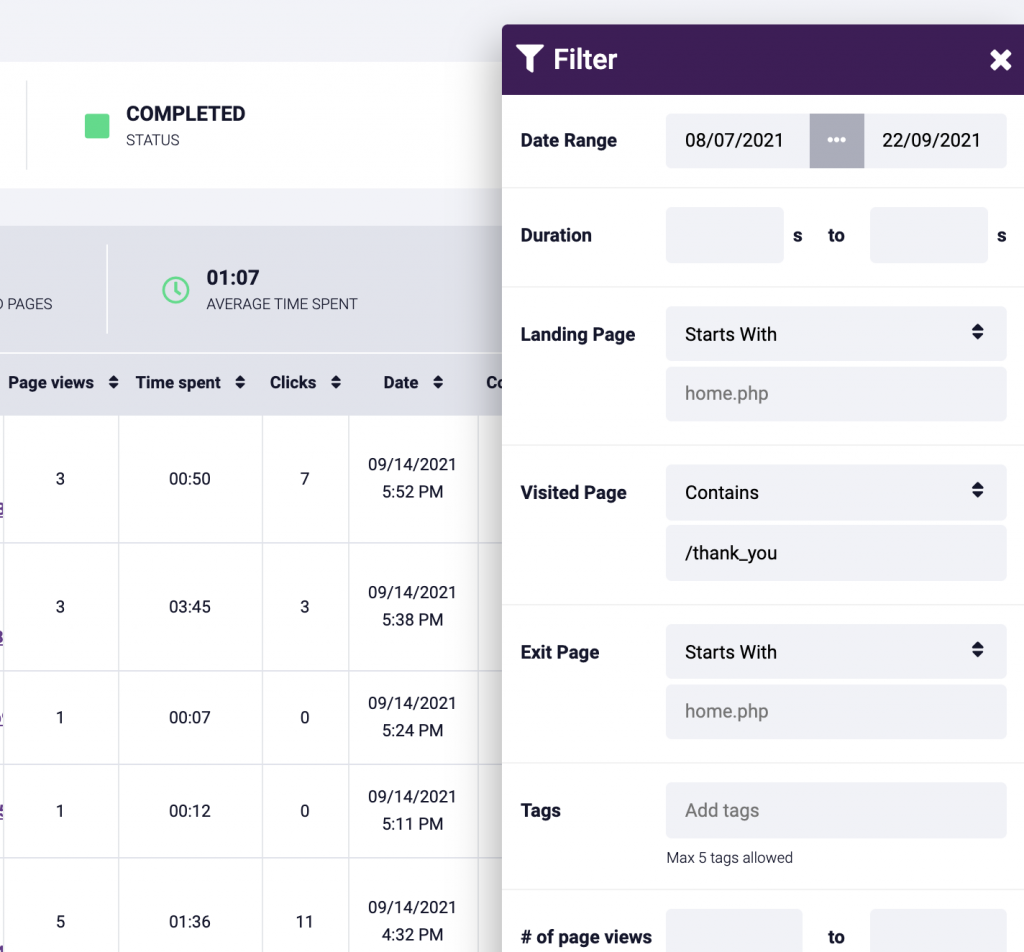
That might narrow down your sessions by 90% but if you had 2,000 sessions to begin with then that’s still 200 sessions.
So now let’s try to narrow down our group, even more, let’s say you recently made an update to your category pages and are interested in how users who made a purchase are interacting with the new pages.
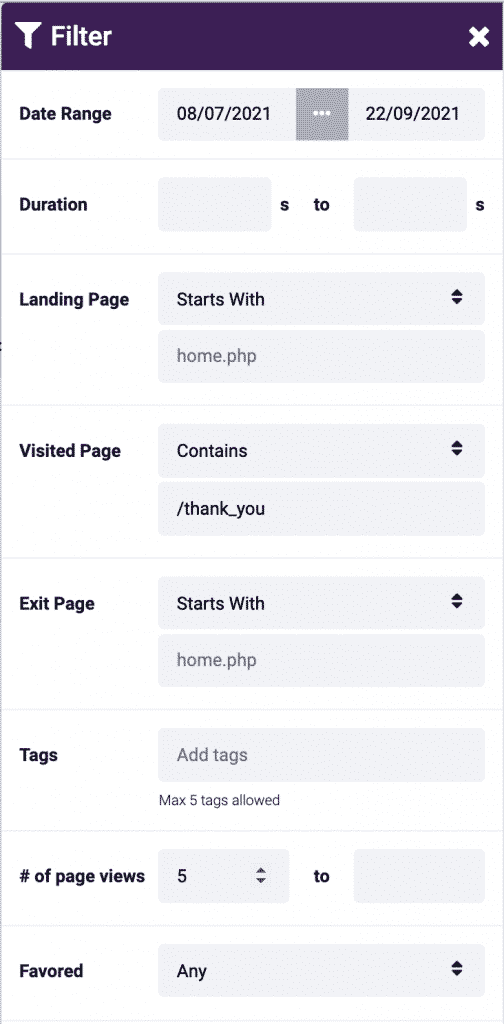
Now you’ll have about 100 sessions, and that’s a good starting point.
Which sessions to watch?
Now that we have about 100 sessions, users who made a purchase after visiting our category pages, which ones should we watch?
A good first step would be to watch sessions that had the most and the least interaction with our website. FigPii allows you to sort your sessions by the number of pages visited or the number of clicks.
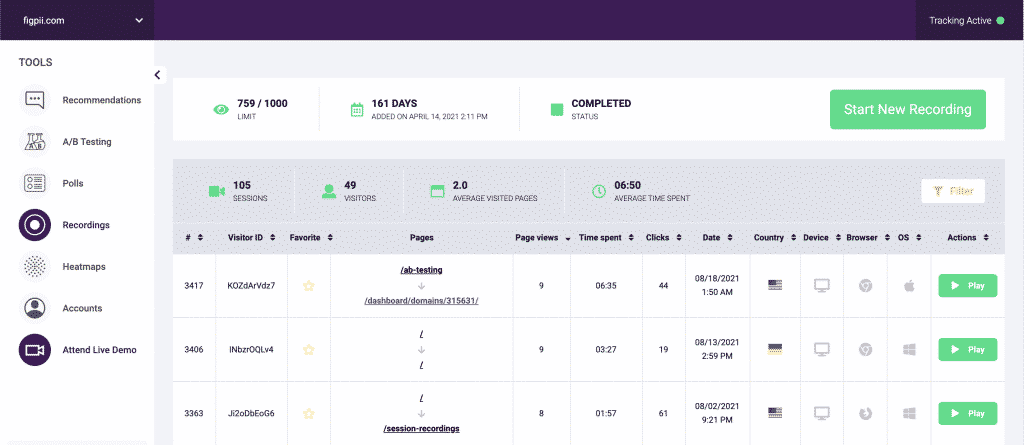
Isabela, our CRO specialist says:
I sort session recordings by pages and devices I want to view and then I sort them by Pageviews, Time spent, and Clicks so I have at least 40 videos to watch.”
These are some useful segments you might benefit from:
- Converted Sessions vs. Abandon Sessions
- Bounced Sessions vs. Pages per session more than one
- Session Duration less than a minute vs more than 3 minutes
- Home landed sessions vs. Detailed page (product or article) landed sessions
- New Users vs Returning Users
- Subscribers vs Guest users (for SaaS businesses)
- Earlier Signup vs Loyal User
Intent – Why did she do that?
In a session video, we see when someone scrolled down a page, clicked links in the navigation bar at the top of the screen (which is usually missed), and looked away from her device for extended periods of time, indicating boredom with content all without clicking anything!
Own the analysis
Because of the inherent subjectivity and nature of session recording analysis, it’s best to limit the number of people doing it! Master the task but ask for other opinions every once in a while, especially with interesting sessions.
Look for patterns!
Humans are amazing at recognizing patterns, no one is as good at it as we are. Put your superpower to some use.
Focus on the “why” and “how”
Analyzing session replays is a qualitative research method. Always consider why the person is doing what he or she is doing when you watch a session. What was going on in their mind? Are they interacting with elements the way that was intended?
Come up with alternative reasoning
Examine your first views and ideas. Even when something appears self-evident, try a new perspective and evaluate how it fits.
This straightforward technique can assist you in overcoming your own cognitive barriers.
Involve your team members
If possible, share your findings with other team members.
FigPii allows you to publicly share certain session recordings, use this feature to ask for your coworker’s opinion.
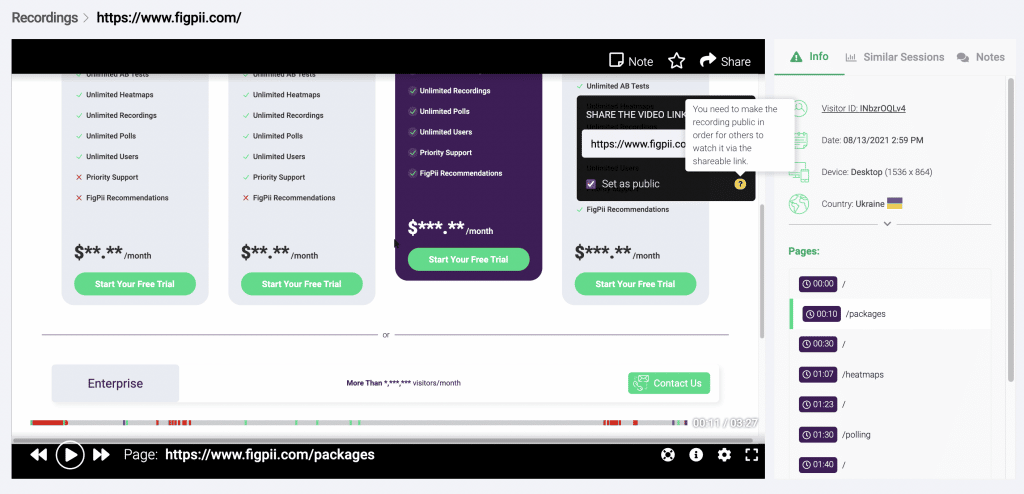
We’ve all got a thousand other tasks, but you don’t need to ask your workmates to go through the entire process.
You can ask them to watch two or three recordings, without sharing your findings first, and see if they have the same opinions as you do.
Patterns to identify from your session recordings:
- The order of the element’s attention
- The journey users passed to complete actions.
- Which links users use to navigate pages
- How users move around on the page and where they stop scrolling
- Which actions completions take a too long
- Witch elements got ignored and which messages are missed
- How visitors interact or fail to with buttons and clickable elements
- Unusual mouse activity, for example, wild scrolling or repeated clicking
- See how users interact with specific elements
- Why they clicked on the link and suddenly clicked the back button?
- Did they read all page’s texts or just scanning the page? (Scroll speed)
Check out our article on Top 8 insights to gather from session recording for more interesting insights you can gather from session recordings.
Inherent subjectivity – How to report your findings?
At its core, session replay is a textbook example of qualitative research – the researcher examines the individual sessions of users interacting with a website, aided by all sorts of detailed information that originates from the session event log, such as what UI element the user clicked and when.
In Session Recording, you can filter through user sessions depending on a variety of aspects, ranging from the characteristics of the user themselves (such as their identifiers), through the properties of the session (like the geographical location or the device being used), and going right into the user activity (such as what pages the user visited and how they interacted with the elements found there).
To make session recording analysis more objective, use a list of predefined questions you can ask yourself while reporting your findings.
Example of session recording analysis session questions:
- What did they do?
- What exactly is this person trying to do?
- Can the users use and understand our design?
- Is everything on the website working for them as it should?
- Are there any things that cause issues? Anything that frustrates the users?
- How long did it take them to complete each step?
- Why did they choose that option?
- Which message was missed?
- Is this the primary goal of the session or an exception behavior coming from someone who is a novice user?
And the most important question:
- How can we solve this problem, if it exists?
Conclusion
Session recording is only a part of a wider phenomenon called Conversion Rate Optimization. The insights generated from the use of session recording are simply an observation when used in isolation. However, when employed in conjunction with other components of CRO (heatmaps, polls, and AB testing), these same insights become extremely helpful in increasing your conversion and understanding your conversion pain points.
This article goes through every aspect of session recording, from its purpose to its applications and limits. Using session recording correctly and within a well-defined process, can provide priceless visitor behavior data that can assist marketers to improve their websites.
If you think this guide helped you answer your questions, and if you found it informative and useful give FigPii a try, we have all the tools you need to understand your users and increase your conversion.
Start your free trial ->
Spot issues on your website and your conversion funnel today!


